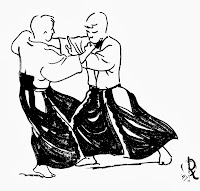 |
| Typical page from my journal |
I usually start off with the date, the class I'm taking (our system has several different arts rolled into one), where I'm taking the class, and who the instructor is. If I can, I write down who was there in class, or at least with whom I was training. After that, I write down a general idea of what I did that day. Which kata we worked on, what techniques we did, who and how I sparred. Then the tricky part. I write down any observations I can think of. By concentrating on these observations, it will make you pay more attention next time. Included in these observations is any weaknesses I notice in my own techniques, kata, or something I got caught on in sparring (or randori if you do something similar). This is where you have to be honest with yourself. The journal is a road map of your martial path, so not being honest will influence how you train later.
 |
| Vocab pages |
In between my dated entries, I include any information gleaned from other sources (say a martial arts blog). Sometimes, I get inspired by a piece of art, a poem, or even a TV show. When this happens I write it down what the source was, and what the inspiration is, and why it was important.
 Personally, I like to sketch things as well. Again I reiterate, you don't have to be great at drawing to do this. Stick figures work. In fact sometimes they can show the ideas of the form more clearly. Simple drawing usually work the best. I'm a big fan of the simplicity of Oscar Ratti's art. If you've read Secret of the Samurai, or Aikido and the Dynamic Sphere, you've seen his art. I draw postures, or specific aspects of locks or throws. Then I add specific notes pointing out things I learned or noticed about them from that particular class. To make things more dynamic, I usually have different colored inks for writing the notes.
Personally, I like to sketch things as well. Again I reiterate, you don't have to be great at drawing to do this. Stick figures work. In fact sometimes they can show the ideas of the form more clearly. Simple drawing usually work the best. I'm a big fan of the simplicity of Oscar Ratti's art. If you've read Secret of the Samurai, or Aikido and the Dynamic Sphere, you've seen his art. I draw postures, or specific aspects of locks or throws. Then I add specific notes pointing out things I learned or noticed about them from that particular class. To make things more dynamic, I usually have different colored inks for writing the notes.If you don't like drawing, take pictures. I found these things called Picture Corners from a craft store. You know those little white corners that used to hold pictures into photo albums? You can take pictures and use the picture corners to hold them in your journal. I take pictures with my iPhone (or whatever) and can send them to Walgreens who will print them out for about $.40 a piece. I then use a ultra thin sharpie marker to write notes on the picture.
Tips for keeping the journal
Here are a small list and explanation of ideas or tips that I've used, or heard about from others that may help you continue to keep your journal.
 |
| Pages with sketches |
1. Record your journal information as soon as possible.
As soon as class is over is the best. The ideas and impressions are still fresh in your mind. If that is not possible, then as soon as you get home. If not then then at least within 24 hours. If you don't believe me, try it. Write a journal entry right after class. You'll have a lot to write about. Then next time, write the entry a day later. You'll be amazed how that little time erodes your memory.
2. Make sure your write both positive and negative things.
If you end up just self criticizing, you'll stop writing. Write about what you did well that class as well. It is just as important to know what your doing right as it is what your doing wrong. Sometimes trying new things can be negative and positive. Write about both aspects. What worked, what didn't work, and why.
3. Review your own work occasionally.
Don't do it everyday, but every once in a while go back and read over what you wrote. It will help you look at what you've done, as well as review what still needs to be done. If you notice that every time you spar, you're not happy with the result, then maybe you need to talk to your instructor as to why that is. Are you missing something, or is it something else? Sometimes just identifying
4. Keep at it.
Everyone will fall off the journaling wagon occasionally. When you come back, don't try to cram everything in that has happened in the mean time. Start each entry just talking about what happened that day.
5. The Journal is for you.
Don't write the journal for anyone else. That is why the physical aspect is important as well. You have to feel like writing in it. If you want it to be private, keep it private. You don't have to have anyone else read it. They don't have the need right to read it. It is OK to tell someone "no, my journal is private."
If you have any more ideas to help please feel free to add them to the comments.













